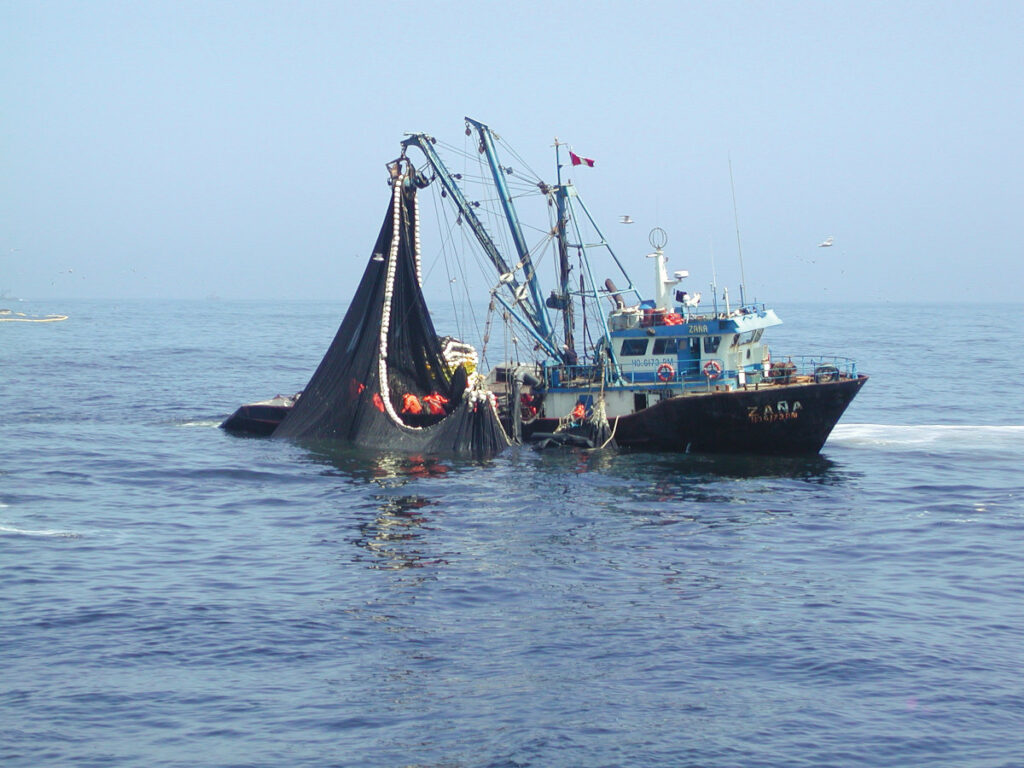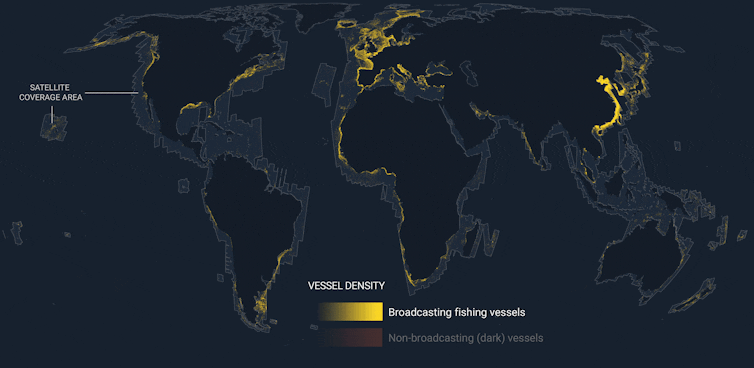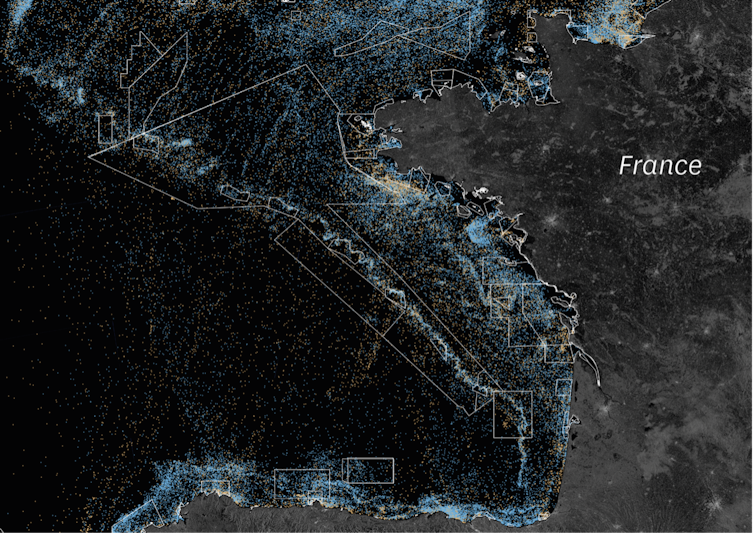Most industrial fishing in marine protected areas goes unmonitored
Are marine protected areas really effective in protecting marine life and artisanal fishing? While, in the wake of Unoc-3, countries such as France and Greece are announcing the creation of new areas, a study published this July 24 in the journal Science shows that the majority of these zones remain exposed to industrial fishing, a large proportion of which escapes any public surveillance. A large proportion of marine areas do not comply with scientific recommendations and offer little or no protection for marine life.
Raphael Seguin, University of Montpellier and David Mouillot, University of Montpellier

The ocean's health is at risk, and by extension, so is ours. The ocean regulates climate and rainfall patterns, feeds more than three billion human beings and sustains our cultural traditions and economies.
Historically, industrial fishing has been the primary source of destruction for marine life: over a third of fish populations are overexploited, a figure that is probably underestimated, and populations of large fish have declined by 90-99% depending on the region.
Added to this are global warming, which is having a major impact on most marine ecosystems, and new, as yet poorly understood, pressures linked to the development of offshore renewable energies, aquaculture and mining.
Marine protected areas, an effective tool for protecting oceans and people
In the face of these threats, we have a proven tool for protecting and restoring marine life: marine protected areas (MPAs). The principle is simple: we exploit the ocean too much, so we need to define certain zones where we can regulate, or even prohibit, impacting activities to allow marine life to regenerate.
MPAs aim to achieve threefold ecological, social and climatic efficiency. They enable the recovery of marine ecosystems and the fish populations that can reproduce there. Some allow only small-scale fishing, creating zones of non-competition that protect more environmentally-friendly methods and create jobs. They also allow leisure activities such as scuba diving. Last but not least, they protect environments that storeCO2, thereby helping to regulate the climate.

As part of theKunming-Montreal global agreement signed at COP 15 on biodiversity, governments committed to protecting 30% of the ocean by 2030. Officially, more than 9% of the ocean's surface is now under protection.
To be effective, all MPAs should, according to scientific recommendations, either prohibit industrial fishing and exclude all human activities, or authorize some of them, such as artisanal fishing or scuba diving, depending on the level of protection. In practice, however, a large proportion of MPAs do not follow these recommendations and do not exclude the industrial activities that are most destructive to marine ecosystems, which makes them little, if at all, effective.
Real protection or communication tool?
Indeed, in order to quickly achieve international protection targets and proclaim their political victory, governments often create large protected areas on paper, but with no real effective protection on the ground. France, for example, claims to protect more than 33% of its waters, but only 4% of these benefit from regulations and a truly effective level of protection, including only 0.1% in metropolitan waters.
At the UN Ocean Summit held in Nice in June 2025, France, which is also opposed to a European regulation banning bottom trawling in MPAs, announced that it would label 4% of its metropolitan waters as strongly protected and ban trawling there. The problem is that almost all of these zones are located in deep waters... where bottom trawling is already banned.
The situation is therefore critical: in the European Union, 80% of marine protected areas do not prohibit industrial activities. Worse still, the intensity of bottom trawling is even higher in these areas than outside. Worldwide, most MPAs allow fishing, and only a third of large MPAs are truly protected.
What's more, the true extent of industrial fishing in MPAs remains largely unknown on a global scale. Our study aims to fill this gap.
The reality of industrial fishing in protected areas
Historically, it has always been very difficult to know where and when boats go fishing. This made it very difficult for scientists to monitor industrial fishing and its impacts. A few years ago, the NGO Global Fishing Watch published a dataset based on the Automatic Identification System (AIS), a system originally designed for safety reasons, which provides public and transparent information on the position of large fishing vessels around the world. In the European Union, this system is mandatory for all vessels over 15 meters.
The problem is that most fishing vessels don't always transmit their position via the AIS system. There are various reasons for this: they don't necessarily have to, the vessel may be in an area with poor satellite reception, and some turn it off deliberately to mask their activity.
To fill this knowledge gap, Global Fishing Watch has combined this AIS data with satellite images from the Sentinel-1 program, on which vessels can be detected. A distinction is therefore made between vessels that are tracked by AIS, and those that are not, but are detected on satellite images.

The areas are effective, but only because they are located where few boats go fishing in the first place.
Our study looks at the presence of fishing vessels tracked or not tracked by AIS in over 3,000 coastal MPAs worldwide between 2022 and 2024. During this period, two-thirds of industrial fishing vessels present in MPAs were not publicly tracked by ISA, a proportion equivalent to that observed in unprotected areas. This proportion varied from country to country, but untracked fishing vessels were also present in the marine protected areas of EU member states, where position transmission via AIS is mandatory.
Between 2022 and 2024, we detected industrial fishing vessels in half of the MPAs studied. Our results, in line with another study published in the same issue of the journal Science, show that the presence of industrial fishing vessels was indeed lower in truly protected MPAs, the few that prohibit all extractive activity. This is good news: where regulations exist and are effectively managed, MPAs effectively exclude industrial fishing.
On the other hand, we tried to understand the factors influencing the presence or absence of industrial fishing vessels in MPAs: is it the actual level of protection or the location of the MPA, its depth or distance from the coast? Our results indicate that the absence of industrial fishing in an MPA has more to do with its strategic location - very coastal, remote or not very productive areas, and therefore not very exploitable - than with its level of protection. This reveals an opportunistic strategy for locating MPAs, which are often placed in little-fished areas in order to achieve international objectives more easily.

A little-known and underestimated fishery
Finally, a question remained: does a detection of a fishing vessel on a satellite image mean that the vessel is actually fishing, or is it simply in transit? To answer this question, we compared the number of vessel detections by satellite imagery in an MPA with its known fishing activity, estimated by Global Fishing Watch from AIS data. If the two indicators are correlated, and the number of vessel detections on satellite images is linked to a greater number of fishing hours, this implies that it is possible to estimate the proportion of "invisible" fishing activity based on detections not tracked by AIS.
We found that the two indicators were highly correlated, showing that satellite detections are a reliable indicator of fishing activity in an MPA. This reveals that industrial fishing in MPAs is much higher than previously estimated, by at least a third according to our results. However, most research and conservation organizations, NGOs and journalists rely on this single source of transparent public data, which reflects only a limited part of reality.
Many questions remain: the resolution of satellite images prevents us from seeing vessels under 15 meters and misses a significant proportion of vessels between 15 and 30 meters. Our results therefore underestimate industrial fishing in protected areas, and completely bypass small vessels under 15 meters in length, which can also be considered as industrial fishing, particularly if they adopt methods such as bottom trawling. What's more, the satellite images used cover most coastal waters, but not most of the high seas. MPAs on islands or far from the coast are therefore not included in this study.
Towards genuine ocean protection
Our findings are in line with those of other studies on the subject, and lead us to make three recommendations.
On the one hand, the quantity of marine protected areas does not determine their quality. MPA definitions must follow scientific recommendations and prohibit industrial fishing, otherwise they should not be considered true MPAs. Secondly, MPAs must also be located in areas subject to fishing pressure, not just in lightly exploited areas. Finally, fisheries monitoring must be strengthened and made more transparent, in particular by generalizing the use of AIS on a global scale.
In the future, thanks to high-resolution optical satellite imagery, we'll also be able to detect smaller fishing vessels, giving us a broader and more complete picture of fishing activities around the world.
For the time being, the urgent need is to bring the definitions of marine protected areas into line with scientific recommendations, and to systematically prohibit industrial activities within these zones, in order to build genuine protection for the ocean.
Raphael Seguin, PhD student in marine ecology, with the University of Montpellier and BLOOM, University of Montpellier and David Mouillot, Professor of Ecology, MARBEC laboratory, University of Montpellier
This article is republished from The Conversation under a Creative Commons license. Read theoriginal article.